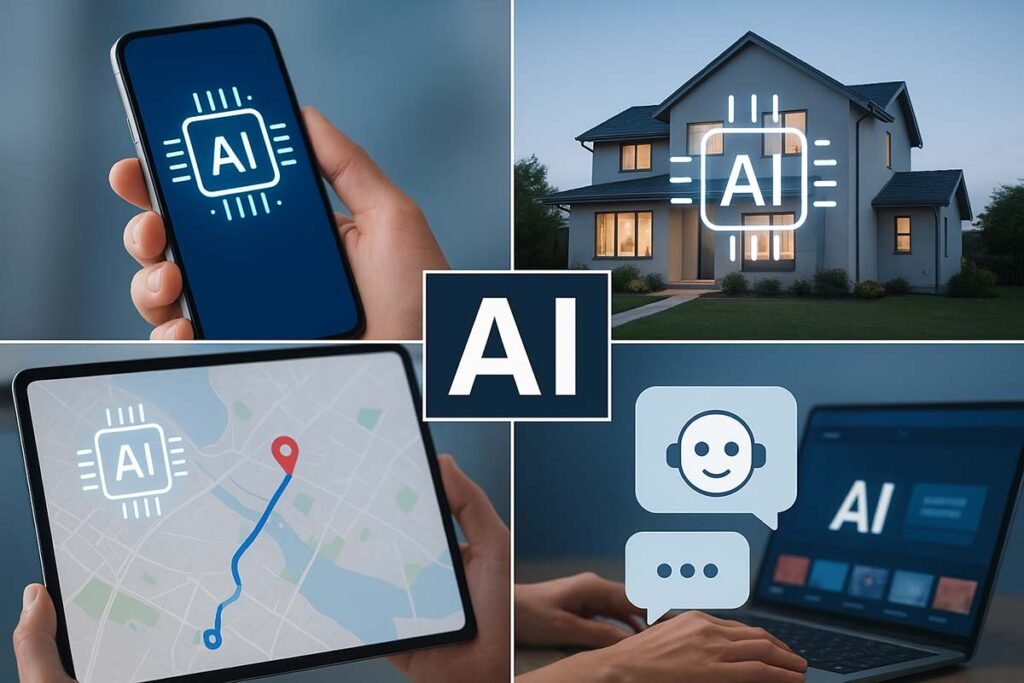Artificial Intelligence (AI) isn’t something waiting in the future — it’s already a huge part of our daily lives in 2025. Whether you’re shopping online, driving to work, or watching Netflix, AI is quietly working behind the scenes to make things faster, smarter, and more personalized.
In this article, we’ll explore 15 real examples of AI in action — many of which you probably use every single day without even realizing it.
1. Voice Assistants (Siri, Alexa, Google Assistant)
Voice assistants use Natural Language Processing (NLP) to understand and answer your requests — from playing music to controlling smart home devices.
Example: Saying “Alexa, turn on the living room lights” triggers AI-based voice recognition and smart device control.
2. Personalized Shopping Recommendations
E-commerce sites like Amazon use AI to study your browsing and buying history, then recommend products you’re more likely to purchase.
Example: You browse for cameras, and the next day Amazon suggests related lenses and tripods.
3. Social Media Feeds
AI decides what appears on your Facebook, Instagram, or TikTok feed by analyzing your likes, follows, and time spent on posts.
Example: Watching three cake-making videos might result in AI showing you similar baking content for weeks.
4. Email Spam Filters
Every time an unwanted email lands in your spam folder, AI is at work identifying suspicious phrases, sender behavior, and keywords.
Example: AI prevents phishing scams from reaching your inbox by detecting unusual links and text.
5. Navigation & Traffic Prediction
Google Maps and Waze use AI to analyze traffic patterns and suggest the fastest route.
Example: AI reroutes you to avoid a sudden traffic jam, saving 20 minutes on your commute.
6. Predictive Text & Autocorrect
Your smartphone keyboard predicts the next word you might type, based on your past typing behavior.
Example: Typing “See you” prompts your phone to suggest “tomorrow!” without you writing it.
7. Banking Fraud Detection
Banks use AI to detect unusual transactions and alert you instantly.
Example: Your card is temporarily blocked when AI detects a purchase in another country that doesn’t match your spending habits.
8. Streaming Recommendations (Netflix, Spotify, YouTube)
AI uses your watch/listen history to suggest new movies, shows, or songs you might enjoy.
Example: Watching a mystery series prompts Netflix to recommend similar detective dramas.
9. Smart Home Devices
Smart thermostats, air purifiers, and refrigerators adjust based on your behavior and environment.
Example: A smart AC learns your preferred temperature and adjusts automatically when you arrive home.
10. Online Customer Support (AI Chatbots)
Many customer service chats you use online start with AI-powered bots before a human steps in.
Example: Asking a telecom provider about your bill online may be answered instantly by an AI chatbot.
11. Photo Organization & Face Recognition
Photo apps like Google Photos use AI to group pictures by person, location, or event.
Example: Searching “beach” in your photo app instantly shows all your vacation beach photos.
12. Ride-Hailing Apps (Uber, Lyft, Ola)
AI matches riders with drivers and calculates dynamic pricing based on demand.
Example: Prices spike during a holiday rush because AI predicts high demand.
13. Online Language Translation
Google Translate now uses AI-based machine translations that learn context for more accurate results.
Example: Translating “It’s raining cats and dogs” into Spanish gives a contextually relevant phrase, not a literal animal storm.
14. Fitness & Health Tracking
Smartwatches use AI to track sleep patterns, exercise habits, and heart rate to give health suggestions.
Example: Your smartwatch reminds you to stand up after 50 minutes of inactivity.
15. Search Engines (Google, Bing)
Every time you search online, AI ranks results based on relevance, your location, and search history.
Example: Searching “best coffee near me” shows personalized, location-based results.
Why This Matters for You
AI in everyday life is proof that the technology isn’t just for tech companies — it’s shaping consumer experiences, helping businesses grow, and making our lives more convenient. Understanding where and how AI works can also help you create business opportunities or learn valuable new skills.
In 2025, AI is everywhere — working silently in apps, devices, and services we use daily. Knowing how it impacts your life can help you use it more effectively and even open doors to careers or businesses in the booming AI industry.
💡 Next Step: Start noticing where AI is already helping your daily life, and think about how you can use those same tools for your personal or business growth.




Pingback: Beginner’s Guide to Artificial Intelligence: What It Is, How It Works, and Why It Matters in 2025 - firstspost.com
Pingback: Top Free AI Tools for Students in 2025: Boost Learning & Productivity - firstspost.com
Pingback: Best AI Chrome Extensions to Boost Productivity in 2025 - FirstsPost